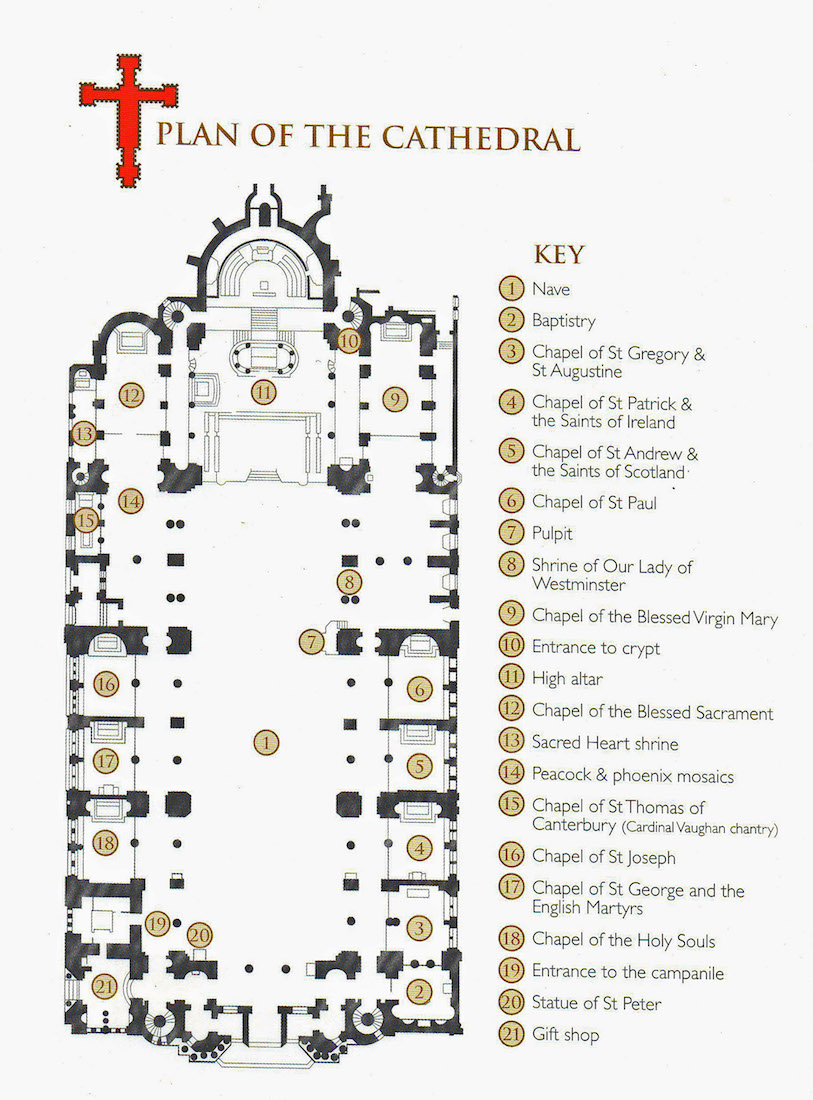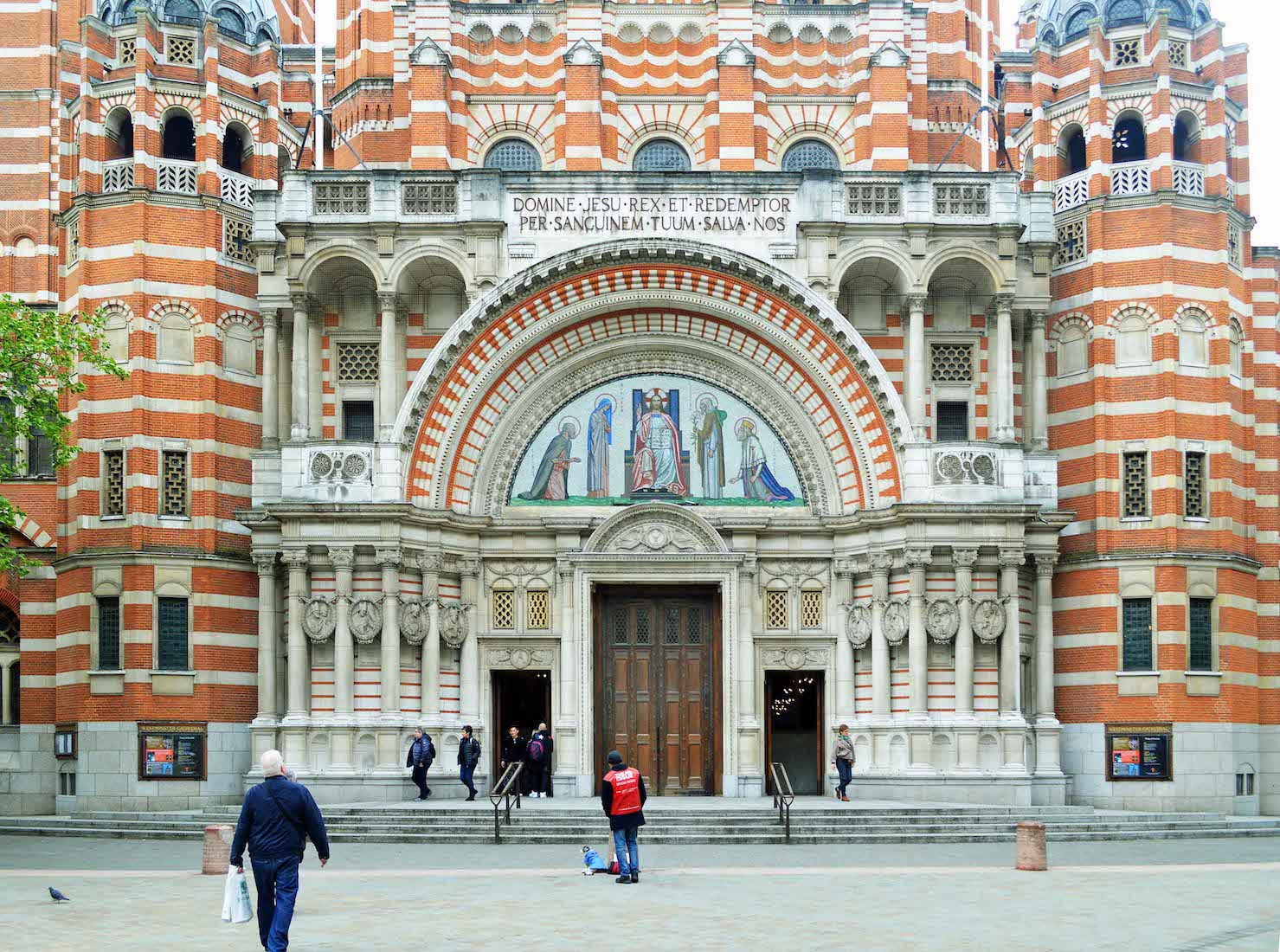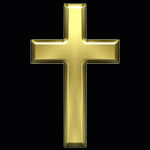WELCOME TO
WESTMINSTER CATHEDRAL
LONDON, ENGLAND CATHOLIC
PAUL SCOTT

This is the official Cathedral Plan and numbering. The photographs on this site are (as usual!) in a different order. We first photograph the exterior front of the building, and then enter at the West (bottom) end. After a general view of the nave, we investigate the inner West wall, followed by the North and South chapels. We finish up at the sanctuary.
The Cathedral is enormous. It is basically a very large rectangle, modified at the East (top) end. The nave is surmounted by three domes, and is completely open, but is lined on either side by ornate chapels. The prominent bell tower is in the bottom left corner.
Where the side chapels end, level with the pulpit (7), the nave opens into North and South transepts. These are unusual in that they do not extend beyond the line of the outer nave walls.
A brief history of the Cathedral is given below. However, if you want to begin your tour of the Cathedral immediately, tap / click on START . You can also access intermediate points in the tour by a tap / click on the following links:
01. START
27. Chapel of Blessed Sacrament
NOTE ON MAGNIFYING IMAGES
With this website format the images are large enough for most purposes. If there is a need for greater magnification of an image, go to the identical photo on
https://www.flickr.com/photos/paulscottinfo/albums
and use Command - + (Mac) or Windows - + (Windows).
HISTORY
[Wikipedia]
Westminster Cathedral is the mother church of the Roman Catholic Church in England and Wales.
The site on which the cathedral stands in the City of Westminster was purchased by the Diocese of Westminster in 1885, and construction was completed in 1903. It is the largest Roman Catholic church in England and Wales and the seat of the Archbishop of Westminster.
Designed by John Francis Bentley in neo-Byzantine style, and accordingly made almost entirely of brick, without steel reinforcements, John Betjeman called it ‘a masterpiece in striped brick and stone’ and said that it shows that ‘the good craftsman has no need of steel or concrete’.
History
In the late 19th century, the Roman Catholic Church’s hierarchy had only recently been restored in England and Wales, and it was in memory of Cardinal Wiseman (who died in 1865, and was the first Archbishop of Westminster from 1850) that the first substantial sum of money was raised for the new cathedral. The land was acquired in 1884 by Wiseman’s successor, Cardinal Manning, having previously been occupied by the second Tothill Fields Bridewell prison.
There were two false starts: one in 1867 (under architect Henry Clutton) and another in 1892 (architect Baron von Herstel). Then construction started in 1895 under Manning’s successor, the third archbishop, Cardinal Vaughan, with John Francis Bentley as architect, and the cathedral was built in a style heavily influenced by Byzantine architecture.
The cathedral opened in 1903, a year after Bentley’s death. One of the first public services in the cathedral was Cardinal Vaughan’s requiem; the cardinal died on 19 June 1903. For reasons of economy, the decoration of the interior had hardly been started and still much remained to be completed. Under the laws of the Catholic Church at the time, no place of worship could be consecrated unless free from debt and having its fabric completed. The consecration ceremony took place on 28 June 1910, although the interior was never finished.
In 1895, the cathedral was dedicated to the Most Precious Blood of Our Lord Jesus Christ. This is indicated by the Latin dedication above the portal arch: Domine Jesus Rex et Redemptor per Sanguinem tuum salva nos (English translation: ‘Lord Jesus, King and Redeemer, heal us through your blood’). The additional patrons are St Mary, the mother of Jesus, St Joseph, his foster father, and St Peter his reputed vicar. The cathedral also has numerous secondary patrons: St Augustine and all British saints, St Patrick and all saints of Ireland. The Feast of the Dedication of the Cathedral is celebrated each year on 1 July, which from 1849 until 1969 was the feast of the Most Precious Blood of Our Lord Jesus Christ.
In 1977, as part of her Silver Jubilee Celebrations, Queen Elizabeth II visited the cathedral to view a flower show.
On 28 May 1982, the first day of his six-day pastoral visit to the United Kingdom, Pope John Paul II celebrated Mass in the cathedral.
On St Andrew's Day (30 November) 1995, at the invitation of Cardinal Basil Hume, Queen Elizabeth again visited the cathedral but this time she attended Choral Vespers, the first participation of the Queen in a Roman Catholic church liturgy in Great Britain.
On 18 September 2010, on the third day of his four-day state visit to the United Kingdom, Pope Benedict XVI celebrated Mass in the cathedral.
In January 2011 the cathedral was the venue for the reception and later ordination of three former Anglican bishops into the newly formed Personal Ordinariate of Our Lady of Walsingham.
In 2012, the cathedral was the host of two episodes of the BBC Four three-part documentary series named ‘Catholics’. The first episode looked at women who attend and/or work at the cathedral and their faith. The third episode looked at the men training to become priests in the Church at Allen Hall seminary, and in the episode there was a brief scene of their ordination at the cathedral.
https://en.wikipedia.org/wiki/Westminster_Cathedral



